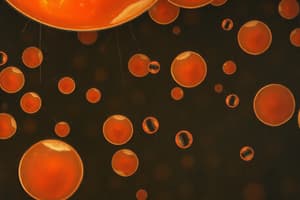Podcast
Questions and Answers
What fluid do lymph vessels carry, which contains lymphocytes and lipids?
What fluid do lymph vessels carry, which contains lymphocytes and lipids?
- Serum
- Cerebrospinal fluid
- Plasma
- Lymph (correct)
Which organ is primarily responsible for hematopoiesis during the adult period?
Which organ is primarily responsible for hematopoiesis during the adult period?
- Thymus
- Spleen
- Bone marrow (correct)
- Liver
Which type of stem cell is known for giving rise to all human tissue cells?
Which type of stem cell is known for giving rise to all human tissue cells?
- Pluripotent stem cells
- Multipotent stem cells
- Totipotent stem cells (correct)
- Unipotent stem cells
What type of cells can pluripotent stem cells produce?
What type of cells can pluripotent stem cells produce?
Which of the following sources is NOT recognized for pluripotent stem cells?
Which of the following sources is NOT recognized for pluripotent stem cells?
What is one of the primary properties of peripheral blood?
What is one of the primary properties of peripheral blood?
In which stage of hematopoiesis does the liver become the primary site?
In which stage of hematopoiesis does the liver become the primary site?
What type of hematopoiesis occurs exclusively in the bone marrow?
What type of hematopoiesis occurs exclusively in the bone marrow?
During what period does the myeloid stage of hematopoiesis begin?
During what period does the myeloid stage of hematopoiesis begin?
Which of the following best describes the condition of bone marrow during infancy?
Which of the following best describes the condition of bone marrow during infancy?
During which trimester does the fetal hematopoiesis begin?
During which trimester does the fetal hematopoiesis begin?
What distinguishes yellow marrow from red marrow?
What distinguishes yellow marrow from red marrow?
What is the main anatomical site for hematopoiesis during childhood and adult life?
What is the main anatomical site for hematopoiesis during childhood and adult life?
What is extramedullary hematopoiesis?
What is extramedullary hematopoiesis?
Which type of stem cells are involved in producing myeloid and lymphoid cells?
Which type of stem cells are involved in producing myeloid and lymphoid cells?
At what point does the bone marrow become the primary site of hematopoiesis?
At what point does the bone marrow become the primary site of hematopoiesis?
What does CFU-S stand for in hematopoiesis?
What does CFU-S stand for in hematopoiesis?
Which cells are produced by the Myeloid Stem Cell (MSC)?
Which cells are produced by the Myeloid Stem Cell (MSC)?
What characterizes progenitor cells?
What characterizes progenitor cells?
Which of the following is NOT a product of the Lymphoid Stem Cell (LSC)?
Which of the following is NOT a product of the Lymphoid Stem Cell (LSC)?
What function do colony-forming units (CFUs) serve in progenitor cell culture?
What function do colony-forming units (CFUs) serve in progenitor cell culture?
What is the primary source of erythropoietin hormone (EPO) in the human body?
What is the primary source of erythropoietin hormone (EPO) in the human body?
Which vitamins are essential for red blood cell production?
Which vitamins are essential for red blood cell production?
In which structures does red blood cell formation occur after the age of five?
In which structures does red blood cell formation occur after the age of five?
What triggers an increase in erythrocyte production?
What triggers an increase in erythrocyte production?
What is the main function of erythropoietin hormone (EPO) in the body?
What is the main function of erythropoietin hormone (EPO) in the body?
What is the first stage in the maturation sequence of erythropoiesis?
What is the first stage in the maturation sequence of erythropoiesis?
During which stage does hemoglobin start to appear in the erythrocyte maturation process?
During which stage does hemoglobin start to appear in the erythrocyte maturation process?
Which enzyme is synthesized during the maturation of erythrocytes?
Which enzyme is synthesized during the maturation of erythrocytes?
What characterizes mature erythrocytes?
What characterizes mature erythrocytes?
What is the approximate lifespan of erythrocytes in circulation?
What is the approximate lifespan of erythrocytes in circulation?
What is the process called by which erythrocytes exit the blood vessel walls?
What is the process called by which erythrocytes exit the blood vessel walls?
At which stage do erythrocytes lose their nuclei?
At which stage do erythrocytes lose their nuclei?
What percentage of red blood cells do reticulocytes normally constitute?
What percentage of red blood cells do reticulocytes normally constitute?
Flashcards are hidden until you start studying
Study Notes
Hematopoiesis
- Blood cell production is called hematopoiesis.
- The main hematopoietic organs are:
- Liver and Spleen (prenatal period)
- Bone Marrow (adult period)
- The secondary hematopoietic organ is the reticuloendothelia system (RES)
- This system is comprised of cells responsible for immune responses.
- The first cell that produces all other blood cells is called the Pluripotent Stem Cell (PSC) or hemocytoblast.
- Hemocytoblasts are capable of dividing into two lineage pathways: lymphoid and myeloid.
Hematopoiesis in the Fetus (Prenatal Period)
- Hematopoiesis in the fetus occurs in three anatomic stages:
- Mesoblastic Stage: occurs during the first trimester (0-2 months) in the yolk sac and mesothelial layers of the placenta.
- Hepatic Stage: occurs during the second trimester (2-7 months) in the liver, spleen, and lymphoid tissues.
- Myeloid Stage: occurs during the third trimester (5-9 months) with the bone marrow becoming the primary site for hematopoiesis.
- The bone marrow becomes the main hematopoietic organ in childhood and adult life.
Hematopoiesis in Infancy and Adulthood
- During infancy (up to 4 years of age), all marrow cavities actively produce blood cells, a state known as "Red Marrow".
- In adulthood, erythropoiesis becomes restricted to flat bones such as the skull, vertebrae, sternum, ribs, and pelvic bones, as well as the ends of long bones.
- The shafts of long bones become populated with fat and are called "yellow marrow".
Types of Hematopoiesis
- Intramedullary hematopoiesis: normal hematopoiesis occurring in the bone marrow.
- Extramedullary hematopoiesis: occurs outside the bone marrow, primarily in the liver and spleen.
- This occurs when the bone marrow cannot meet the physiological needs of the tissues.
Hematopoietic Stem and Progenitor Cells
- These cells are also called Hematopoietic or Committed cells.
- They are responsible for generating new generations of blood cells.
- There are two types of progenitor cells:
- Myeloid Stem Cells (MSC): exist in the bone marrow and produce the myeloid group of blood cells.
- Lymphoid Stem Cells (LSC): exist in the bone marrow and produce the lymphoid group of blood cells.
Pluripotent Stem Cells (PSC) or Hemocytoblasts (HSCs)
- Properties:
- Self-renewing
- Multipotential
- Found in bone marrow of adults
- Found in umbilical cord blood
- Extramedullary hematopoiesis occurs in fetal hematopoietic tissue (liver and spleen) of an adult when the bone marrow cannot meet the physiological needs of the tissues.
Colony Forming Units (CFU)
- CFU-S refers to pluripotent stem cells that can differentiate into all types of blood cells.
- These cells divide into two lineages:
- Lymphoid Precursor (CFU-LSC)
- Myeloid Precursor (CFU-GEMM)
- In culture media, progenitor cells are defined as colony forming units (CFU).
- Each of the CFUs can produce a colony of one hematopoietic lineage under appropriate growth conditions.
Myeloid Stem Cell - Colony Forming Unit (CFU)
- Cells produced from the MSC and found in the peripheral blood include:
- CFU-GEMM:
- CFU-E: Erythrocytes
- CFU-GM:
- Granulocytes (neutrophils, basophils, eosinophils)
- Monocytes and macrophages
- CFU-M: Megakaryocytes (Platelets)
- CFU-GEMM:
Lymphoid Stem Cell - Colony Forming Unit (CFU)
- Cells produced from the LSC and found in the peripheral blood include:
- T-Lymphocytes
- B-Lymphocytes
Red Blood Cell (RBC) Formation after Birth
- From birth up to 5 years old, all bones produce RBCs, including the long bones and sternum.
- After 5 years, RBC production is restricted to the vertebrae, sternum, ribs, and ilium.
Synthesis Requirements for RBC Production
- Iron: crucial for hemoglobin synthesis.
- Protein: needed for the synthesis of globin chains in hemoglobin.
- Vitamins:
- B12 - essential for DNA synthesis and cell division.
- B6 - required for enzymatic reactions involved in RBC synthesis.
- Folic acid - needed for DNA synthesis and cell division.
- C - important for iron absorption and metabolism.
- E - helps protect RBCs from damage by free radicals.
- Copper: for cofactors in enzymes synthesizing RBCs.
- Erythropoietin hormone (EPO): key hormone that stimulates and regulates RBC production in the bone marrow.
Erythropoietin Hormone (EPO)
- Nature: Glycoprotein - a 193-amino acid glycoprotein.
- Location of gene: Chromosome 7.
- Source: 90% from the kidneys and 10% from the liver.
- Activity: Stimulates and regulates the bone marrow to produce erythrocytes.
Regulation of Erythropoiesis
- Erythrocyte production is regulated by:
- Erythropoietin hormone (EPO)
- Level of oxygen in the tissues
Stimuli for Erythropoiesis
- Low levels of O2 in the tissues increase erythropoiesis.
- Increase in exercise increases erythropoiesis.
- Hemorrhaging increases erythropoiesis.
Erythrocyte Maturation Steps
- Erythrocytes comprise 10-30% of all hematopoietic cells in the bone marrow.
- Production Site: Only in the bone marrow.
- Target: Synthesis of:
- Hemoglobin (Hb)
- Enzymes such as:
- Glucose 6 dehydrogenase phosphate (G6PD)
- Pyruvate kinase (PK)
- Period: About 8-10 days.
Erythrocyte Maturation Sequence (Erythropoiesis)
- Pronormoblast: no hemoglobin, nucleus containing nucleoli.
- Early Normoblast: nucleoli disappear, small amounts of hemoglobin present.
- Intermediate Normoblast: cytoplasm deep blue due to high RNA content, increasing hemoglobin synthesis.
- Late Normoblast: nucleus smaller, pyknosis (nuclear condensation), nuclear extrusion.
- Reticulocyte: remnant of RNA, ongoing synthesis of proteins and Hb, comprises 1% of red cells.
- Erythrocyte: mature red blood cell, round, biconcave, disc shaped, diameter 7.8 um, flexible and deformable, non-nucleated.
Transfer of RBCs into Circulation (Diapedesis)
- Erythrocytes exit blood vessel walls through a process called Diapedesis.
- This occurs because the pores in the vessel wall are smaller than the cells.
- Small portions of the cell squeeze through these pores.
Erythrocyte Properties in the Peripheral Blood
- Non-nucleated
- Flexible biconcave disc
- Lifespan: 100- 120 days in circulation.
- Function: Transport O2 to tissues and remove CO2.
Studying That Suits You
Use AI to generate personalized quizzes and flashcards to suit your learning preferences.




